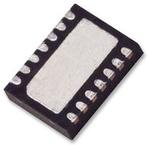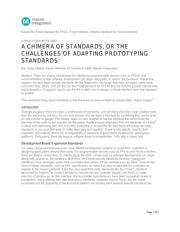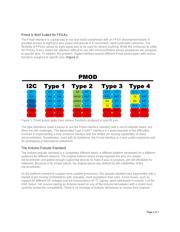下载

Keywords: Pmod standard for FPGA, Pmod interface, Arduino standard for microcontrollers
APPLICATION NOTE 5902
A CHIMERA OF STANDARDS, OR THE
CHALLENGES OF ADAPTING PROTOTYPING
STANDARDS
By: Greg Steiert, Senior Member of Technical Staff , Maxim Integrated
Abstract: There are always connections for interfacing programmable devices such as FPGAs and
microcontrollers so that software development can begin along with, or before, the hardware. This article
explains the very loose pseudo standards for the “expansion interfaces” that have emerged, some more
consistent than others, and will discuss the Pmod standard for FPGAs and the Arduino psuedo standard for
microcontrollers. It explains how to use the MAX14661 mux to design a simple interface from one standard
to another.
"
The wonderful thing about standards is that there are so many of them to choose from." Grace Hopper
Introduction
Through the years there has been a proliferation of standards, and not many industries have created more
than the electronics industry. Do you ever wonder why we have a standard for something that seems to be
an odd number or gauge? The debate rages on over whether or not the standard that determined the
diameter of the solid rocket boosters for the space shuttle actually originated from the backside of a horse.
Curious and interesting, yes, but, it is more productive to accept the fact that there will always be many
standards so we must find ways to make them play well together. There is one specific area for both
engineers and makers, where the incompatibility of standards is particularly troublesome: prototyping
platforms. Fortunately, there are ways to mitigate these incompatibilities. Let's take a closer look.
Development Board Expansion Standards
For years component manufacturers have offered development systems to assist their customers in
designing applications around their parts. For programmable devices such as FPGAs and microcontrollers,
there are always connections for interfacing to the other components so software development can begin
along with, or prior to, the hardware. With time, very loose pseudo standards for these "expansion
interfaces" have emerged, some more consistent than others. FPGA vendors such as Xilinx
have driven
some of these standards, such as FMC specification, to make it as easy as possible for customers to
migrate to the newest platform. Xilinx has also used third-party standards like the Pmod™ standard
developed by Digilent
to connect peripheral modules to host controller boards, and there is a wide
selection of peripherals for this interface. Microcontroller manufacturers have been somewhat slower to
standardize, many utilizing their own proprietary interfaces. However, market forces like the maker
movement and the popularity of the Arduino® platform are herding them towards pseudo standards too.
1
2
®
®
Page 1 of 7








